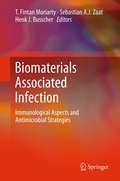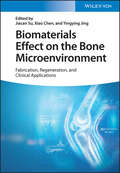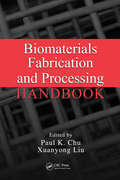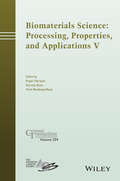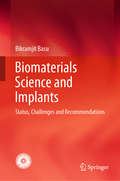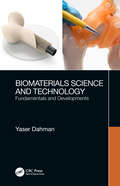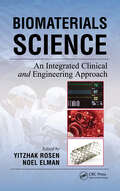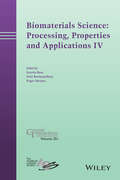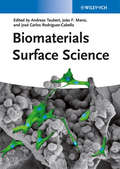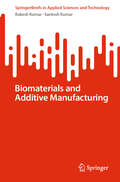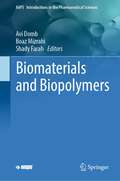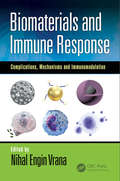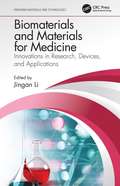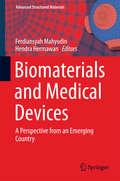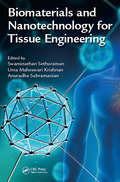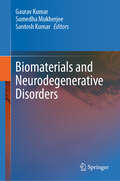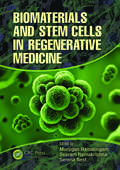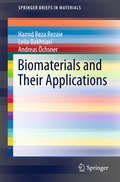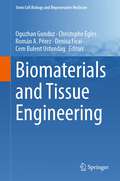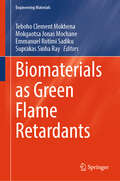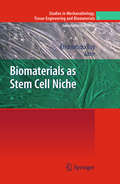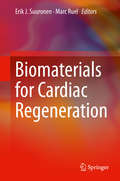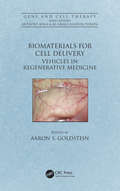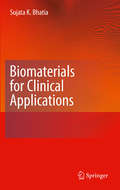- Table View
- List View
Biomaterials Associated Infection: Immunological Aspects and Antimicrobial Strategies
by Henk J. Busscher Sebastian A.J. Zaat Fintan MoriartyBiomaterials associated infection (BAI) is one of the most common complications associated with implantation of any biomaterial regardless of form or function. These infections usually involve bacterial colonization and biofilm formation on the biomaterial itself, rendering the infection impervious to antimicrobials and host defenses. In addition, it is becoming increasingly clear that infection of the surrounding tissues also plays an important role in BAI, and that the infection may be influenced by the composition and design of the implanted biomaterial. In this book, worldwide leaders in the field address this critical problem in the translation of biomaterials research into clinical practice. The book begins with an emphasis on the latest research in the pathogenesis of BAI from microbiological, immunological, and materials science perspectives. The current state of the art in antimicrobial activation of biomaterials through surface modification and the incorporation of antimicrobial agents is then discussed. In the concluding chapters, successful translation of a selection of antimicrobial technologies from preclinical research into clinical use is described alongside a discussion of the utility of these devices and perspectives for future development. This book is essential reading for researchers and clinicians who are interested in understanding the fundamentals of BAI, the latest in antimicrobial materials research, and the state of the art in clinically available antimicrobial containing medical devices.
Biomaterials Effect on the Bone Microenvironment: Fabrication, Regeneration, and Clinical Applications
by Xiao Chen Jiacan Su Yingying JingBiomaterials Effect on the Bone Microenvironment Practical resource on clinical bone regeneration from a variety of related interdisciplinary researchers Biomaterials Effect on the Bone Microenvironment focuses on the structure-activity relationship between bone biomaterials and microenvironment regulation, presenting a systematic exposition from all aspects of biomaterials regulated microenvironment in bone regeneration and covering design strategies, applications, and mechanisms of biomaterials that regulate bone microenvironment, along with the methods for manufacturing biomaterials and their clinical translation. The subject’s potential challenges and future development direction are discussed, and the design and initiative principle of tailored biomaterials with various features, including bioactive components and physicochemical property, are elucidated in depth. Numerous biomaterials, including natural and synthetic, are summarized and compared. Their advantages and features are also evaluated, particularly in bone microenvironmental regulation and bone generation. Moreover, the stimulation mechanism of the microenvironment to bone generation is discussed in detail, including mechanical-support effect, redox effect, pro-angiogenesis effect, inflammatory immune effect, and anti-aging effect. Biomaterials Effect on the Bone Microenvironment provides further coverage of sample topics such as: Role of bone microenvironment and its associated biomaterials in modulation bone diseases, reviewing the biomaterials used to regulate bone microenvironment Relationship between biological factors of various materials and physiological functions in bone microenvironment Application of the third generation of biomaterials, which would regenerate the bone to regulate bone microenvironment Emerging biological material manufacturing technology and mechanisms of novel biomaterial modulating microenvironment for bone regeneration Future outlook of bone tissue engineering along with the general process of bone remodeling and regeneration With comprehensive coverage of one of the most promising and valuable candidates for clinical bone regeneration, Biomaterials Effect on the Bone Microenvironment is an ideal resource for materials scientists, biotechnologists, biochemists, bioengineers, orthopedists, and clinical chemists who want to stay on the cutting edge of this rapidly evolving field.
Biomaterials Fabrication and Processing Handbook
by Paul K. Chu Xuanyong LiuFocusing on a lucrative and increasingly important area of biomedicine, the Biomaterials Fabrication and Processing Handbook brings together various biomaterials production and processing aspects, including tissue engineering scaffold materials, drug delivery systems, nanobiomaterials, and biosensors. With contributions from renowned interna
Biomaterials Science
by Roger Narayan Susmita Bose Amit BandyopadhyayTaking place at the David L. Lawrence Convention Center, Pittsburgh, Pennsylvania, this CT Volume contains 17 papers from the following 2014 Materials Science and Technology (MS&T'14) symposia: Next Generation Biomaterials Surface Properties of Biomaterials
Biomaterials Science and Implants: Status, Challenges and Recommendations
by Bikramjit BasuBiomaterials as a research theme is highly socially relevant with impactful applications inhuman healthcare. In this context, this book provides a state-of-the-art perspective onbiomaterials research in India and globally. It presents a sketch of the Indian landscapeagainst the backdrop of the international developments in biomaterials research.Furthermore, this book presents highlights from major global institutes of importance,and challenges and recommendations for bringing inventions from the bench to thebedside. It also presents valuable information to those interested in existing issuespertaining to developing the biomaterials research ecosystem in developing countries.The contents also serve to inspire and educate young researchers and students to take upresearch challenges in the areas of biomaterials, biomedical implants, and regenerativemedicine. With key recommendations for developing frontier research and policy, italso speaks to science administrators, policymakers, industry experts, and entrepreneurs onhelping shape the future of biomaterials research and development.
Biomaterials Science and Technology: Fundamentals and Developments
by Yaser DahmanBiomaterials Science and Technology: Fundamentals and Developments presents a broad scope of the field of biomaterials science and technology, focusing on theory, advances, and applications. It reviews the fabrication and properties of different classes of biomaterials such as bioinert, bioactive, and bioresorbable, in addition to biocompatibility. It further details traditional and recent techniques and methods that are utilized to characterize major properties of biomaterials. The book also discusses modifications of biomaterials in order to tailor properties and thus accommodate different applications in the biomedical engineering fields and summarizes nanotechnology approaches to biomaterials. This book targets students in advanced undergraduate and graduate levels in majors related to fields of Chemical Engineering, Materials Engineering and Science, Biomedical Engineering, Bioengineering, and Life Sciences. It assists in understanding major concepts of fabrication, modification, and possible applications of different classes of biomaterials. It is also intended for professionals who are interested in recent advances in the emerging field of biomaterials.
Biomaterials Science: An Integrated Clinical and Engineering Approach
by Yitzhak Rosen"This book is essential when designing, developing and studying biomedical materials.� provides an excellent review-from a patient, disease, and even genetic point of view-of materials engineering for the biomedical field. � This well presented book strongly insists on how the materials can influence patients' needs, the ultimate drive for biomedic
Biomaterials Science: Ceramic Transactions, Volume 251
by Roger Narayan Susmita Bose Amit BandyopadhyayCeramic Transactions, Volume 242; Biomaterials Science - Processing, Properties and Applications IIISusmita Bose, Roger Narayan, and Amit Bandyopadhyay, EditorsThis CT Volume contains14 contributed papers from the following 2012 Materials Science and Technology (MS&T'12) symposia: Next Generation BiomaterialsSurface Properties of Biomaterials
Biomaterials Surface Science
by José Carlos Rodríguez-Cabello Andreas Taubert Joao F. ManoAt the interface of biology, chemistry, and materials science, this book provides an overview of this vibrant research field, treating the seemingly distinct disciplines in a unified way by adopting the common viewpoint of surface science.The editors, themselves prolific researchers, have assembled here a team of top-notch international scientists who read like a "who's who" of biomaterials science and engineering. They cover topics ranging from micro- and nanostructuring for imparting functionality in a top-down manner to the bottom-up fabrication of gradient surfaces by self-assembly, from interfaces between biomaterials and living matter to smart, stimuli-responsive surfaces, and from cell and surface mechanics to the elucidation of cell-chip interactions in biomedical devices. As a result, the book explains the complex interplay of cell behavior and the physics and materials science of artificial devices.Of equal interest to young, ambitious scientists as well as to experienced researchers.
Biomaterials and Additive Manufacturing (SpringerBriefs in Applied Sciences and Technology)
by Rakesh Kumar Santosh KumarThis book addresses the challenges of using metallic biomaterials in implants. It delves into the selection process for these materials, considering factors like mechanical strength, biocompatibility, and resistance to wear and tear. However, the primary focus is on understanding and combating corrosion. Different types of corrosions are explored, highlighting their mechanisms and potential consequences. Existing research on surface modification techniques is reviewed, offering methods to improve the longevity and safety of implants. The book then introduces the exciting world of additive manufacturing (AM), a revolutionary technique for creating implants. It explores various AM technologies and their suitability for creating biomaterials (metallic’s, ceramics and polymers). Subsequently, the diverse applications of AM in biomaterials and biomedical devices are explored. The book explores various post-processing methods used to refine parts created with AM. These methods not only improve the surface finish but can also enhance the overall properties of the implant. By analyzing existing research and exploring innovative techniques, this book aims to equip researchers and professionals with the knowledge to develop better metallic biomaterials. Ultimately, the goal is to create implants that last longer, function flawlessly, and offer a safer and more durable solution for patients.
Biomaterials and Biopolymers (AAPS Introductions in the Pharmaceutical Sciences #7)
by Avi Domb Boaz Mizrahi Shady FarahThis book is written to serve as textbook on biomaterials and biopolymers for faculty and students and thus contains a broad introduction and basic terms, followed by major developments over the years with some emphasis on recent developments and future prospects. It provide a comprehensive overview in biomaterials and biopolymers. All relevant aspects of modern biomaterials, including: synthesis and characterization, biocompatibility and host response, the implementation of novel manufacturing processes, and advanced medical and biotechnological applications. Each chapter provides an overview of a specific field, its importance, the chemistry of biomaterials and the relations between chemical structure and the applications. Each chapter ends with a future prospective/concepts and a friendly quiz/multiple answer questions with answers that serves as a resource to provide guided additional practice.
Biomaterials and Immune Response: Complications, Mechanisms and Immunomodulation (Devices, Circuits, and Systems)
by Nihal VranaThe interactions of the biomaterials with the host immune system is crucial for their functionality. This book aims to provide the reader with a better understanding of the role of the immune system in biomaterial applications. For this end, the book has dedicated chapters for i) explaining immune cells taking part in immune response to biomaterials/immune systems interface; ii) the effect of biomaterial shape, form and physicochemical properties on the response of immune system; iii) biofilm formation on implanted materials as a failure of immune system/biomaterial interactions; iv) tissue-specific effects of immune response and its consequences for tissue engineering and regenerative medicine; v) immune reaction in a clinical context (periodontology). In the field of biomaterials there are significant advances in using immunomodulation techniques to improve the success rates of implantable materials. For better understanding of such techniques it is required to have a full grasp of the biomaterial–immune system interactions. This would greatly enhance the understanding of why the human body reacts to implants in a certain way and how to improve the clinical outcomes by developing immune-instructive biomaterials. Provides keen insight into biomaterial–immune cell interactions Presents an explanation of state-of-the-art methodologies in immunomodulation Offers a concise and simple-to-understand treatment of biomaterial–immune cell interactions for materials scientists in a biology heavy topic Explores a comprehensive overview of biomaterial related complications Provides extensive references at the end of each chapter to enhance study for this very hot research area
Biomaterials and Materials for Medicine: Innovations in Research, Devices, and Applications (Emerging Materials and Technologies)
by Jingan LiBiomaterials and Materials for Medicine: Innovations in Research, Devices, and Applications provides an application-oriented summary of innovations in this rapidly evolving field, offering a view of various directions in biomaterials and medical materials and their advanced uses. Highlights vascular, orthopedic, skin tissue engineering, and nerve tissue engineering biomaterials, including the latest research on therapeutic devices and implants Introduces special stent materials for palliative treatment of esophageal cancer and related technologies of surface modification Discusses use of biomaterials and related designs in drug targeting and controlled release Describes wearable biomedical devices, biomimetic materials, and micronscale and nanoscale biomaterials Details the theoretical calculation and computer simulation of biomaterials as a complementary discipline with physical experimental science This book is aimed at an interdisciplinary group of researchers working on development and application of biomaterials for medical applications in the fields of materials scientists, biomedical engineering, and medicine.
Biomaterials and Medical Devices: A Perspective from an Emerging Country (Advanced Structured Materials #58)
by Hendra Hermawan Ferdiansyah MahyudinThis book presents an introduction to biomaterials with the focus on the current development and future direction of biomaterials and medical devices research and development in Indonesia. It is the first biomaterials book written by selected academic and clinical experts experts on biomaterials and medical devices from various institutions and industries in Indonesia. It serves as a reference source for researchers starting new projects, for companies developing and marketing products and for governments setting new policies. Chapter one covers the fundamentals of biomaterials, types of biomaterials, their structures and properties and the relationship between them. Chapter two discusses unconventional processing of biomaterials including nano-hybrid organic-inorganic biomaterials. Chapter three addresses biocompatibility issues including in vitro cytotoxicity, genotoxicity, in vitro cell models, biocompatibility data and its related failure. Chapter four describes degradable biomaterial for medical implants, which include biodegradable polymers, biodegradable metals, degradation assessment techniques and future directions. Chapter five focuses on animal models for biomaterial research, ethics, care and use, implantation study and monitoring and studies on medical implants in animals in Indonesia. Chapter six covers biomimetic bioceramics, natural-based biocomposites and the latest research on natural-based biomaterials in Indonesia. Chapter seven describes recent advances in natural biomaterial from human and animal tissue, its processing and applications. Chapter eight discusses orthopedic applications of biomaterials focusing on most common problems in Indonesia, and surgical intervention and implants. Chapter nine describes biomaterials in dentistry and their development in Indonesia.
Biomaterials and Nanotechnology for Tissue Engineering
by Swaminathan Sethuraman, Uma Maheswari Krishnan and Anuradha SubramanianNanotechnology and high-end characterization techniques have highlighted the importance of the material choice for the success of tissue engineering. A paradigm shift has been seen from conventional passive materials as scaffolds to smart multi-functional materials that can mimic the complex intracellular milieu more effectively. This book presents a detailed overview of the rationale involved in the choice of materials for regeneration of different tissues and the future directions in this fascinating area of materials science with specific chapters on regulatory challenges & ethics; tissue engineered medical products.
Biomaterials and Neurodegenerative Disorders
by Santosh Kumar Gaurav Kumar Sumedha MukherjeeThe book covers the fundamental aspects of biomaterials, including their introduction, types, synthesis, and characterization. It delves into the field of neuro-compatible biomaterials, examining nervous tissue response and the role of biomaterials in neuroprotection. It discusses clinical trials and applications along with intellectual property rights in neuroprotective biomaterials. The book also explores the innovative neuro-targeted drug delivery system and its potential in improving treatment outcomes. Lastly, it explores biomaterials' impact on neurodegeneration and neuro diagnosis, providing valuable insights for researchers, academicians and doctoral students working in the field of Neuroscience, Neuroprotection, Biomaterial based Neurotherapeutics, Biomaterial based Neuro diagnosis and Biomaterial mediated drug delivery.
Biomaterials and Regenerative Medicine
by Peter X. MaWritten by world-leading experts, this book focusses on the role of biomaterials in stem cell research and regenerative medicine. Emphasising basic principles and methodology, it covers stem cell interactions, fabrication technologies, design principles, physical characterisation and biological evaluation, across a broad variety of systems and biomaterials. Topics include: stem cell biology, including embryonic stem cells, IPS, HSC and progenitor cells; modern scaffold structures, including biopolymer, bioceramic, micro- and nanofiber, ECM and biohydrogel; advanced fabrication technologies, including computer-aided tissue engineering and organ printing; cutting-edge drug delivery systems and gene therapy techniques; medical applications spanning hard and soft tissues, the cardiovascular system and organ regeneration. With a contribution by Nobel laureate Shinya Yamanaka, this is a must-have reference for anyone in the field of biomaterials, stem cell biology and engineering, tissue engineering and regenerative medicine.
Biomaterials and Stem Cells in Regenerative Medicine
by Seeram Ramakrishna Murugan Ramalingam Serena BestWork in the area of biomaterials and stem cell therapy has revealed great potential for many applications, from the treatment of localized defects and diseases to the repair and replacement of whole organs. Researchers have also begun to develop a better understanding of the cellular environment needed for optimal tissue repair and regeneration. Bi
Biomaterials and Their Applications (SpringerBriefs in Materials)
by Andreas Öchsner Hamid Reza Rezaie Leila BakhtiariThis short book presents an overview of different types of biomaterial such as bio ceramics, bio polymers, metals and bio composites, while especially focusing on nano biomaterials and their applications in different tissues. It provides a compact introduction to nano materials for drug delivery systems, tissue engineering and implants, while also reviewing essential trends in the biomaterial field over the last few decades and the latest developments.
Biomaterials and Tissue Engineering (Stem Cell Biology and Regenerative Medicine #74)
by Oguzhan Gunduz Christophe Egles Román A. Pérez Denisa Ficai Cem Bulent UstundagThis contributed volume covers all fundamental principles for researchers and professionals interested in the field of Biomaterials and Tissue Engineering, an interdisciplinary field of research with contributions from biomedical scientists, engineers, and physicians. With a strong focus on biomaterials and scaffolds, the book also covers testing and evaluation pathways for in vitro and in vivo studies. This book also presents a broad range of topics including fundamentals of 3D printing and bioprinting, followed by contemporary technology used in tissue engineering applications as well as currently available biomaterials suitable for tissue repair and regeneration. This volume provides information on: (i) why humans need biomaterials, especially in medical applications, (ii) different types of tissue engineering strategies, and (iii) modeling, characterization, and evaluation of outputs of those strategies. This book is a reference material in the field of tissue engineering, and it is very useful for bachelor, M.Sc., and Ph.D. students, researchers, academics, medical, industry, and healthcare professionals from diverse backgrounds.
Biomaterials as Green Flame Retardants (Engineering Materials)
by Suprakas Sinha Ray Teboho Clement Mokhena Mokgaotsa Jonas Mochane Emmanuel Rotimi SadikuThis book highlights the utilization of biomaterials as emerging suitable and effective flame retardants (FRs) to replace most of the conventional FRs (e.g., halogenated FRs). Biomaterials are considered to be sustainable, biodegradable, and renewable resources. They are abundantly available, which makes them affordable. Information and findings on the characteristics of biomaterials and their use as FRs have been explored. Herein, the tremendous scientific progress made in using biomaterials as flame retardants for a wide range of products is elucidated. The major goal is to draw attention to the opportunities and challenges of switching to biomaterial-based FRs in place of conventional FRs in order to create a sustainable society.
Biomaterials as Stem Cell Niche (Studies in Mechanobiology, Tissue Engineering and Biomaterials #2)
by Krishnendu RoyRecent developments in stem cell biology have opened new directions in cell therapy. This book provides the state-of-the-art developments in using biomaterials as artificial niches for engineering stem cells, both for the purpose of better understanding their biology under 3D biomimetic conditions as well as for developing new strategies for efficient long term maintenance and directed differentiation of stem cells into various therapeutic lineages. Animal and human stem cells of both embryonic and adult origin are discussed with applications ranging from nerve regeneration, orthopedics, cardiovascular therapy, blood cell generation and cancer therapy. Both synthetic and natural biomaterials are reviewed with emphasis on how material-stem cell interactions direct specific signaling pathways and ultimately modulate the cell fate. This book is valuable for biomaterial scientists, tissue engineers, clinicians as well as stem cell biologists involved in basic research and applications of adult and embryonic stem cells.
Biomaterials for Cardiac Regeneration
by Erik J. Suuronen Marc RuelThis book offers readers a comprehensive biomaterials-based approach to achieving clinically successful, functionally integrated vasculogenesis and myogenesis in the heart. Coverage is multidisciplinary, including the role of extracellular matrices in cardiac development, whole-heart tissue engineering, imaging the mechanisms and effects of biomaterial-based cardiac regeneration, and autologous bioengineered heart valves. Bringing current knowledge together into a single volume, this book provides a compendium to students and new researchers in the field and constitutes a platform to allow for future developments and collaborative approaches in biomaterials-based regenerative medicine, even beyond cardiac applications.
Biomaterials for Cell Delivery: Vehicles in Regenerative Medicine (Gene and Cell Therapy)
by Aaron S. GoldsteinThe purpose of this book is to summarize key strategies and recent accomplishments in the area of developing cell/biomaterial constructs for regenerative medicine. The first section is a review of the state-of-the-art of biomaterial carriers and is divided into synthetic and natural materials. A subset of the latter are decellularized organs which retain the structure and some of the biological activities of the target organ. The bulk of the book is devoted to unique problems associated with key tissue and organ targets. Key selling features: Describes developing cell/biomaterial constructs for regenerative medicine Reviews state-of-the-art of biomaterial carriers Summarizes the unique problems associated with key tissue and organ targets Discusses issues associated with clinical translation including quality control, manufacturing practices, nondestructive imaging, and animal models
Biomaterials for Clinical Applications: Novel Technologies For Clinical Applications
by Sujata K. BhatiaBiomaterials for Clinical Applications is organized according to the World Health Organization's report of the top 11 causes of death worldwide, and lays out opportunities for both biomaterials scientists and physicians to tackle each of these leading contributors to mortality. The introductory chapter discusses the global burden of disease. Each of the subsequent eleven chapters focuses on a specific disease process, beginning with the leading cause of death worldwide, cardiovascular disease. The chapters start with describing diseases where clinical needs are most pressing, and then envisions how biomaterials can be designed to address these needs, instead of the more technologically centered approached favored by most books in the field. This book, then, should appeal to chemical engineers and bioengineers who are designing new biomaterials for drug delivery and vaccine delivery, as well as tissue engineering.
